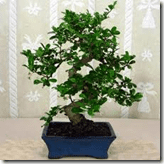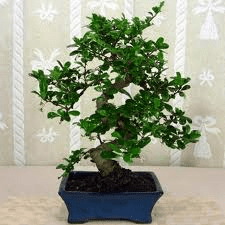 Although there are many spectacular species of trees for growing bonsai, one of the most beautiful is the New Zealand Tea Tree bonsai, also called Leptospermum. This bonsai tree has a longtime reputation for being the ultimate in forbidden bonsai. The tree is beautiful, which produces gorgeous flowers that are similar to small wild roses that have spiky but small evergreen leaves. The bark of the tea tree bonsai has bark that quickly takes on an old and ancient appearance even though it generally takes a little time to thicken. While this bonsai tree is absolutely, beautiful, it can be difficult to grow, often dying before the style is achieved.
Although there are many spectacular species of trees for growing bonsai, one of the most beautiful is the New Zealand Tea Tree bonsai, also called Leptospermum. This bonsai tree has a longtime reputation for being the ultimate in forbidden bonsai. The tree is beautiful, which produces gorgeous flowers that are similar to small wild roses that have spiky but small evergreen leaves. The bark of the tea tree bonsai has bark that quickly takes on an old and ancient appearance even though it generally takes a little time to thicken. While this bonsai tree is absolutely, beautiful, it can be difficult to grow, often dying before the style is achieved.
Originating in New Zealand, the Tea Tree bonsai also grows in Australia and Malaysia even though you will find them growing more as hedge plants in the United States. Of all the types of Tea Tree bonsai, the best for growing is called the Leptospermum Humifusum. This bonsai tree needs a tremendous amount of sunlight. Now, you can keep the plant indoors but you must make sure it is in a room or location where it will receive a good amount of light or it will die. Additionally, do not expect fluorescent lighting to work because the Tea Tree bonsai only likes natural or incandescent light.
For the temperature, you should never let the Tea Tree bonsai dip below 20 degrees. However, in the winter the tree does very well in temperatures ranging from 55 to 60 degrees. You want to plant the Tea Tree bonsai in a pace that is airy but away from any heat sources. You can grow this tree outdoors but because of the amount of light needed and the consistent climate, it can be challenging.
Now for the watering, keep the soil moist. While many bonsai are particular about watering, the tea tree bonsai is exceptionally fussy. This tree will die quickly if not watered enough. Unlike other plants that will wilt and then come back to life, if the Tea Tree bonsai is not watered, it will simply die and quickly, usually within three to four hours. Therefore, it is crucial that you do not under or over water. On the other end of the spectrum over watering will quickly lead to root rot. This means you need to keep the soil moist, never dry, and never wet. For fertilizer, the Tea Tree bonsai needs one that has acid but also with a very dilute solution since the tree will burn easily.
Finally, while some bonsai trees can be trained in numerous styles, the only style that works for this type of tree is the cascade. With outstanding mame potential because of the small leaves and flowers, you want to pinch back as needed to control the growth. When pruning your Tea Tree bonsai, you want to take care not to cut past the leaves, which would result in the branch dying. Even so, this tree responds very well to writing but for repotting, pruning, wiring, they must be done at different times, otherwise, the tree becomes stressed, thus dying. Yes, the Tea Tree bonsai is a challenge to grow but if you enjoy a challenge and love the beauty of bonsai, this would be an excellent choice.

Deprecated: strpos(): Passing null to parameter #1 ($haystack) of type string is deprecated in /home/agriviek8Qv/agriviet.net/public_html/wp-includes/comment-template.php on line 2522